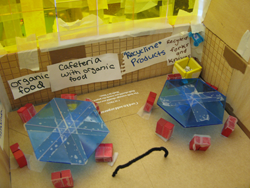The Cambridge Public School District’s
Sustainability Plan outlines five main goals (below) that utilize the
PFEWG™ model for sustainability in planning and implementation. PFEWG™,
(pronounced f-yoog) was originally known as the “Greenfox5” and is a
holistic approach to categorizing, integrating, and implementing
sustainable systems without leaving out any elements of environmental
optimization. The five categories of PFEWG™ include
Products,
Food,
Energy,
Waste, and
Greenspace.
Systems planning for sustainability in the design, operations, and
practice within a community space requires an understanding of the big
picture as well as the smallest of details. Sustainability is all about
interconnectedness, but in order to plan a coherent system, system
planners have to take into account the birds-eye view of a project, so
that they don’t miss any large components.
The categories of PFEWG™ allow for a simplified view of those large
components that complete a sustainable system, and from there, planners
can design and implement the small details that fill out the five
categories, without missing anything in the process.

Often
there is overlap among the five categories, which demonstrates the
nature of interconnectedness in sustainable systems. For example: the
process of retrofitting lighting for an energy-efficiency project in a
building falls under the category of “Energy” in the PFEWG™ model for
sustainability. But lights are also “Products,” so a planner takes into
consideration how to purchase lights that are environmentally-friendly
in their inherent design and material brand. Another example is
cafeteria “Food” where a planner asks questions related to
sustainability such as “how far did the food travel to get here?” That
question inherently relates to “Energy” because the planner has to
consider how much carbon dioxide was used and what the carbon footprint
was if the food wasn’t purchased locally. “Waste” connects to food as
well, when a planner considers how to dispose of the cafeteria food in
an environmentally-friendly way.
In summary, the PFEWG™ model for sustainability has enabled us to design
the Cambridge Public School District’s Sustainability Plan with goals,
strategies, and action items that cover all the bases for
environmentally-friendly options, providing a long-term roadmap for
positive change.